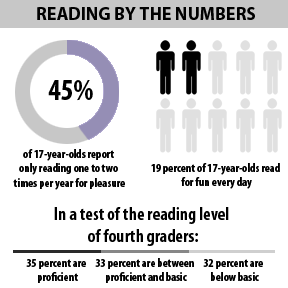Reading with meaning: a lost pastime
One of the biggest changes since the 1990s is the amount of high schoolers who read the newspaper on a daily basis. In 1990, it was reported that about 33 percent of high schoolers read the newspaper every day. However, in 2016, it was reported that only two percent of high schoolers read the newspaper every day. This not only applies to newspapers, but reading in general.
The New Yorker journalist David Denby cites a correlation between teenagers reading less and being a lot busier. Between balancing school, work and home life, teenagers have almost no time to read.
“Reading frustrates their smartphone sense of being everywhere at once. Suddenly, they are stuck on that page, anchored, moored, and many are glum about it. Being unconnected makes them anxious and even angry,” Denby states.
While technology is cited by many parents as the reason why their children don’t obey them, studies done by Common Sense Media does not cite technology as a reason why kids are not reading as much. The internet may serve as a distraction for many children, but it may not be the reason their lack of wanting to read.
At Freedom, the middle school uses a system called Accelerated Reader (AR) in order to ensure that students are reading throughout each of the nine weeks. Each book is worth a certain amount of “AR points” that is determined through the length and difficulty of the book. Students are required to have a certain number of AR points depending on the teacher.
While there may be good intentions behind the AR point system, it may do more harm than good. Reading is like any other hobby; forcing an adolescent to do something isn’t going to make them enjoy it anymore than if they did it on their own.
“Enjoyment is the key thing to look for, as this will determine what they learn most from and what they will commit to as they get older,” mental health professional John Sharry said.
If a student doesn’t enjoy reading now and is forced to read for a grade, it may lead to them not enjoying reading later on in life.
Even some elected officials have started to push away from encouraging teenagers to read and instead spend their time pushing teens to study literature. Instead, state governments have been trying to push students towards degrees in the STEM field rather pursuing literature degrees.
“All the people in the world who want to study French literature can do so, they’re just not going to be subsidized by the taxpayers like engineers will be, for example,” governor of Kentucky Matt Bevin said.
While technology may be one reason for the lack of reading in children and teenagers, there is more reasons than what many parents think. In order to ensure students are reading for many years to come, some changes may need to be made in order to allow for students to have hobbies such as reading that they can enjoy by their own will.



